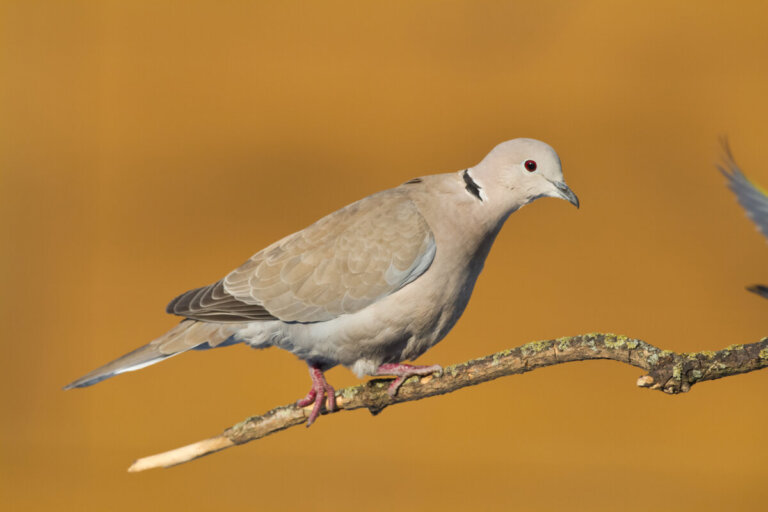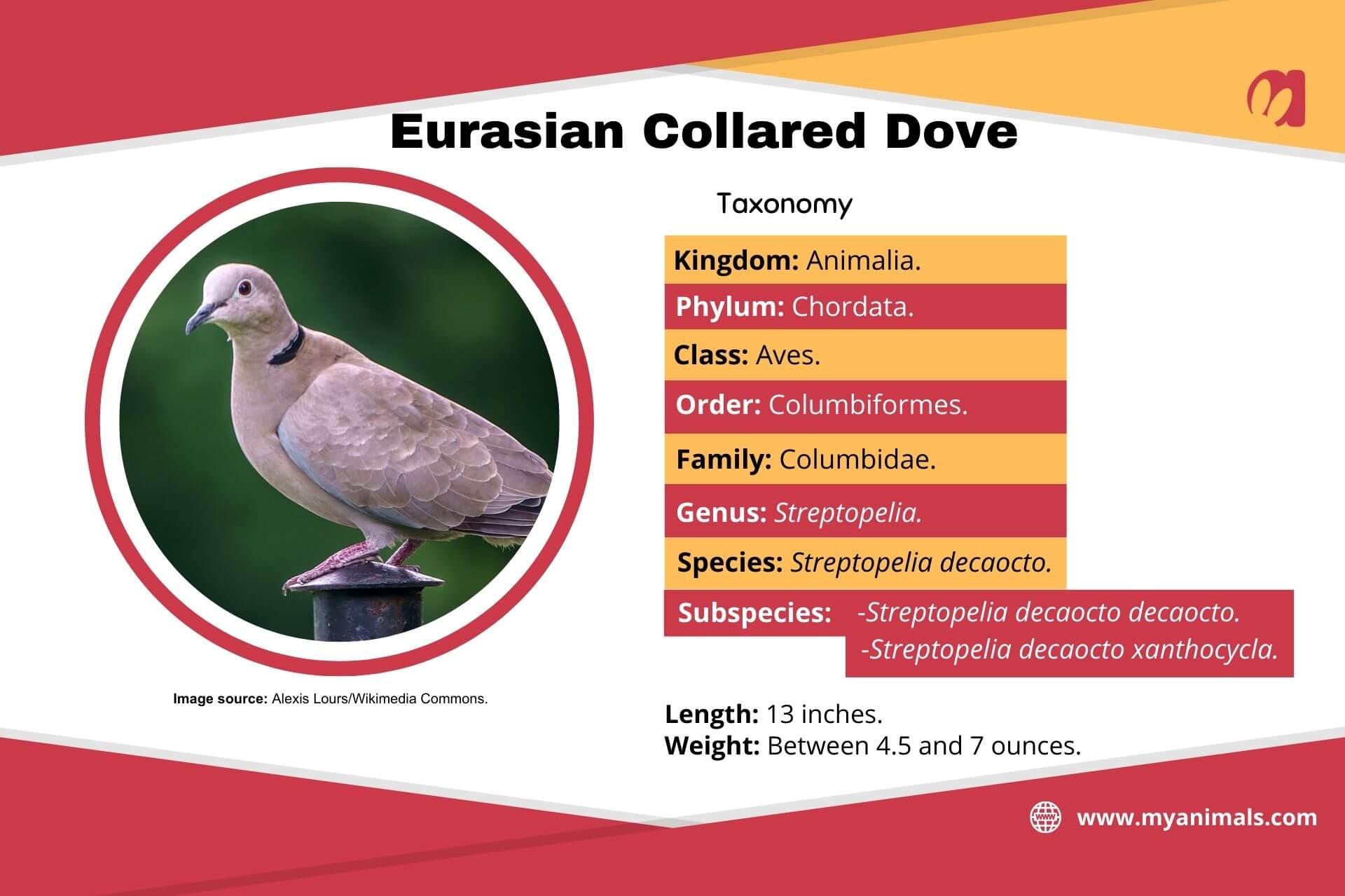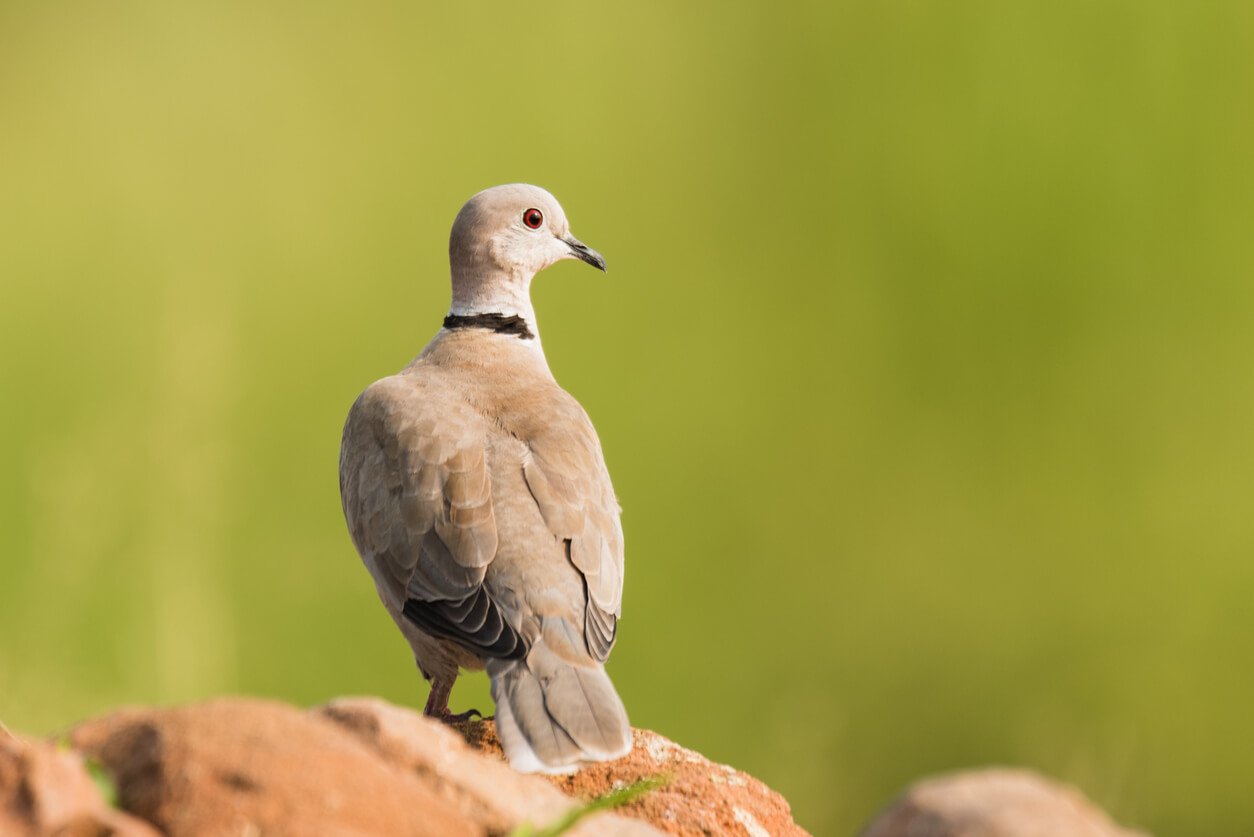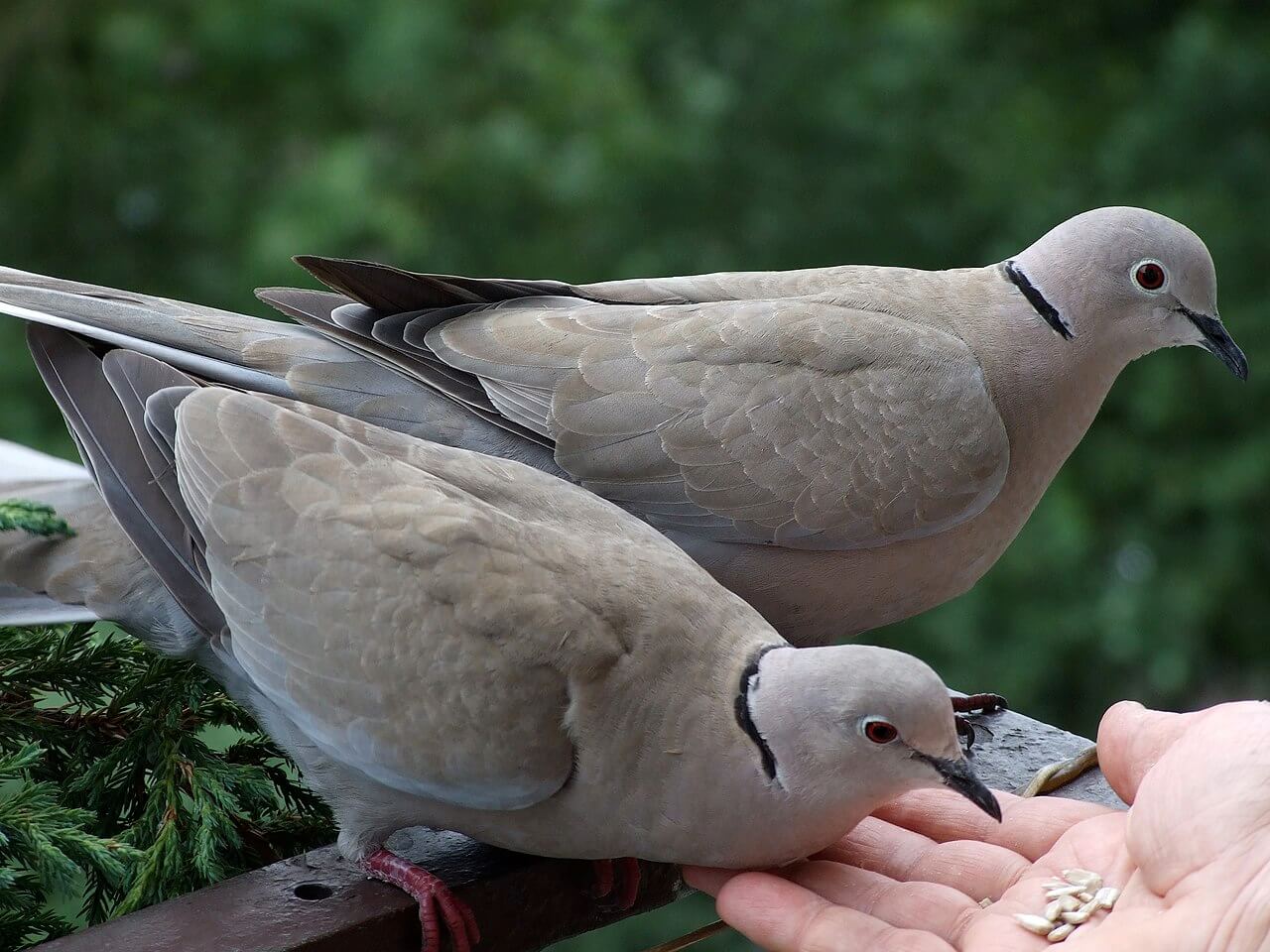How to Care for a Eurasian Collared Dove: A Complete Guide


Written and verified by the veterinarian and zootechnician Sebastian Ramirez Ocampo
The Eurasian collared dove or Streptopelia decaocto –according to its scientific name- is a columbiform bird widely distributed in the territories of Europe, Asia, and North America. Despite its apparent simplicity, this specimen has won the hearts of many bird lovers thanks to its calm nature and friendly character.
Whether you’re looking for a feathered pet or you find a Eurasian collared dove on the street that needs help, this information will be valuable to provide the best care.
In this article, you’ll learn about key aspects, such as feeding and care of the environment as well as the environmental enrichment the bird requires in order to be healthy. Don’t miss the tips we’ll share with you in the following article!
Characteristics of the Eurasian collared dove

Before starting with the aspects related to its care, it’s important to know the origin, morphology, and behaviors of the Eurasian collared dove in nature. This will give an idea of its needs in captivity.
Origin and distribution
The Eurasian collared dove is native to Asia and some Middle Eastern countries. However, due to its ability to travel long distances and reproduce throughout the year, since the 20th century, it has been distributed to other continents such as Europe and North America. This is according to a study in the journal Revista Mexicana de Ornitología.
For example, according to a document in the journal Caldasia, it’s recorded that it arrived in Spain in 1960. As stated by its authors, it began its journey in Asturias. It then spread rapidly along the Cantabrian coast and central Spain, until it colonized the entire Mediterranean coast.
According to recent sightings, the collared dove has reached Central and South America, to countries such as Peru and Mexico, where it’s considered an invasive exotic species.
Morphology

The Eurasian collared dove is a medium-sized bird. As adults, they reach a length of 13 inches and a weight of 4.5 to 7 ounces. Its plumage is sandy brown, with large white patches on the very end of the tail.
In addition, it has an unmistakable black spot bordering half of its neck, which is why it is also known as the Eurasian collared dove.
Its beak is small and opaque, while its iris is dark red. There’s no sexual dimorphism in the species and its flight is characterized by being fast and light, with powerful wing beats.
Behavior
It’s a gregarious bird that lives in groups ranging from 10 to 10,000 individuals. However, it’s also common to observe it alone or with its mate. Its nature isn’t that of a nervous animal, so it has adapted very well to urban environments. It has a predilection for the following places:
- Parks
- Crops
- Environments with exotic vegetation and water available
As indicated in previous lines, it has the capacity to reproduce throughout the year and lays 1 to 2 eggs in each clutch. The young are cared for by both parents and leave the nest at 20 days of age. In the wild, their diet is based on the following components:
- Seeds
- Grains
- Berries
- Small insects
At the same time, the SEO BirdLife portal characterizes the song of the Eurasian collared dove “as a high and penetrating cooing (cu-cuu-cu) repeated insistently.”
Caring for the Eurasian collared dove at home
As you may have noticed, the Eurasian collared dove is an exceptionally adaptable bird. In addition, they’re calm and easy to keep. They don’t usually show aggressive behavior and are very independent animals.
They like all kinds of physical contact and interaction with humans, so they can be excellent pets for anyone. Next, we’ll detail the basic care that should be taken at home to achieve their welfare.
How should they be fed?

Nutrition is a key aspect of their health. It’s normal for many questions to arise about their diet and nutritional requirements but, in reality, they don’t require a very complex diet. For their maintenance, it’s possible to include the following foods:
- Grains and seeds: They should make up only 50% of their diet. If they’re given as the only nutritional source, these animals can become calcium deficient. Among their favorites are canary seed, oats, wheat, brown rice, and sunflower seeds.
- Vegetables and fruits: These foods should be fresh and chopped in small portions. Apples, cherries, cucumbers, oranges, watermelons, tomatoes, bananas, lettuce, and even strawberries, papaya, and carrots can be included. Also, according to some case reports, avocado should be avoided, as it can be toxic to some birds.
- Commercial diets: If it’s an adult Eurasian collared dove, it’ll be difficult for it to accept commercial diets, as it’s not a food that it finds in nature. However, in any case, pellets shouldn’t make up more than 50% of the diet. You can replace grains and seeds, but never fruits and vegetables.
- Water: They should always have clean and fresh water at their disposal. Ideally, it should be changed every day.
It should be noted that they shouldn’t be offered processed foods consumed by humans. If for any reason, your Eurasian collared dove doesn’t accept any of these diets, it’s important to visit an exotic species veterinarian for an evaluation.
How do I prepare the habitat for its arrival?
Considering its size, a conventional cage could be too small for an adult Eurasian collared dove. Therefore, the most advisable thing to do is to adapt an aviary of good dimensions. For example, 30 x 30 cm x 65 cm (width-depth-height) or even larger.
Likewise, to make the bird feel at ease in its environment, you can enrich the surroundings with the following elements:
- Shrubs
- Small plants
- Swings on which it can perch
Aviaries can be adapted both outdoors and indoors, with their advantages and disadvantages.
On the one hand, inside the home, the Eurasian collared dove will be more protected from inclement weather and the risk of being attacked by a predator. However, it may feel overwhelmed by not seeing nature. Outdoors, it’ll enjoy the beautiful scenery but will be more exposed to temperature changes and other animals, such as cats and large hunting birds.
However, if the aviary is made of sturdy materials, this will not be a major problem. In either case, grooming should be done daily to prevent the growth of unwanted pathogens. In addition, it is important to provide a container with water -apart from the drink-, so that it can clean itself.
When the Eurasian collared dove is integrated into its new home, the aviary should be located in a quiet place, far from noises and stimuli that can make it nervous. It’s a good idea to do this for a few days, while it begins to get used to everything around it and its guardians build up its confidence.
What can a Eurasian collared dove get sick from?
Eurasian collared doves are generally very healthy animals with a life expectancy of up to 12 years as pets. However, as an article in The Journal of Parasitology states, they can acquire some parasites, such as the following:
- Ascaridia columbae
- Fuhrmannetta crassula
- Tanaisia bragai
Therefore, it’s essential that, like all pets, they have regular visits to a trained professional. Any signs of illness – such as loss of appetite – should be checked in a timely manner.
What else should I take into consideration?
The Eurasian collared dove can live unaccompanied, although it’s best for them to live in pairs with another member of its species. In addition, if it’s very close to its guardian, it’ll need daily attention so as not to get bored.
This type of bird is very intelligent, so with patience and dedication, it can be taught tricks such as perching on the shoulder or responding to a specific call.
Among other things, because it’s a delicate animal, its handling should be gentle and not be too tight. If you want to handle this bird, but it shows discomfort with the flapping of its wings, it’s best to leave it alone and try again later.
The Eurasian collared dove is the ideal pet
If you’re a bird lover, the Eurasian collared dove can become an ideal companion in your life. Take into account all the recommendations provided in this article, as well as information about its nature and biology. If you apply all the care it requires, you’ll see how it’ll become a member of the family.
The Eurasian collared dove or Streptopelia decaocto –according to its scientific name- is a columbiform bird widely distributed in the territories of Europe, Asia, and North America. Despite its apparent simplicity, this specimen has won the hearts of many bird lovers thanks to its calm nature and friendly character.
Whether you’re looking for a feathered pet or you find a Eurasian collared dove on the street that needs help, this information will be valuable to provide the best care.
In this article, you’ll learn about key aspects, such as feeding and care of the environment as well as the environmental enrichment the bird requires in order to be healthy. Don’t miss the tips we’ll share with you in the following article!
Characteristics of the Eurasian collared dove

Before starting with the aspects related to its care, it’s important to know the origin, morphology, and behaviors of the Eurasian collared dove in nature. This will give an idea of its needs in captivity.
Origin and distribution
The Eurasian collared dove is native to Asia and some Middle Eastern countries. However, due to its ability to travel long distances and reproduce throughout the year, since the 20th century, it has been distributed to other continents such as Europe and North America. This is according to a study in the journal Revista Mexicana de Ornitología.
For example, according to a document in the journal Caldasia, it’s recorded that it arrived in Spain in 1960. As stated by its authors, it began its journey in Asturias. It then spread rapidly along the Cantabrian coast and central Spain, until it colonized the entire Mediterranean coast.
According to recent sightings, the collared dove has reached Central and South America, to countries such as Peru and Mexico, where it’s considered an invasive exotic species.
Morphology

The Eurasian collared dove is a medium-sized bird. As adults, they reach a length of 13 inches and a weight of 4.5 to 7 ounces. Its plumage is sandy brown, with large white patches on the very end of the tail.
In addition, it has an unmistakable black spot bordering half of its neck, which is why it is also known as the Eurasian collared dove.
Its beak is small and opaque, while its iris is dark red. There’s no sexual dimorphism in the species and its flight is characterized by being fast and light, with powerful wing beats.
Behavior
It’s a gregarious bird that lives in groups ranging from 10 to 10,000 individuals. However, it’s also common to observe it alone or with its mate. Its nature isn’t that of a nervous animal, so it has adapted very well to urban environments. It has a predilection for the following places:
- Parks
- Crops
- Environments with exotic vegetation and water available
As indicated in previous lines, it has the capacity to reproduce throughout the year and lays 1 to 2 eggs in each clutch. The young are cared for by both parents and leave the nest at 20 days of age. In the wild, their diet is based on the following components:
- Seeds
- Grains
- Berries
- Small insects
At the same time, the SEO BirdLife portal characterizes the song of the Eurasian collared dove “as a high and penetrating cooing (cu-cuu-cu) repeated insistently.”
Caring for the Eurasian collared dove at home
As you may have noticed, the Eurasian collared dove is an exceptionally adaptable bird. In addition, they’re calm and easy to keep. They don’t usually show aggressive behavior and are very independent animals.
They like all kinds of physical contact and interaction with humans, so they can be excellent pets for anyone. Next, we’ll detail the basic care that should be taken at home to achieve their welfare.
How should they be fed?

Nutrition is a key aspect of their health. It’s normal for many questions to arise about their diet and nutritional requirements but, in reality, they don’t require a very complex diet. For their maintenance, it’s possible to include the following foods:
- Grains and seeds: They should make up only 50% of their diet. If they’re given as the only nutritional source, these animals can become calcium deficient. Among their favorites are canary seed, oats, wheat, brown rice, and sunflower seeds.
- Vegetables and fruits: These foods should be fresh and chopped in small portions. Apples, cherries, cucumbers, oranges, watermelons, tomatoes, bananas, lettuce, and even strawberries, papaya, and carrots can be included. Also, according to some case reports, avocado should be avoided, as it can be toxic to some birds.
- Commercial diets: If it’s an adult Eurasian collared dove, it’ll be difficult for it to accept commercial diets, as it’s not a food that it finds in nature. However, in any case, pellets shouldn’t make up more than 50% of the diet. You can replace grains and seeds, but never fruits and vegetables.
- Water: They should always have clean and fresh water at their disposal. Ideally, it should be changed every day.
It should be noted that they shouldn’t be offered processed foods consumed by humans. If for any reason, your Eurasian collared dove doesn’t accept any of these diets, it’s important to visit an exotic species veterinarian for an evaluation.
How do I prepare the habitat for its arrival?
Considering its size, a conventional cage could be too small for an adult Eurasian collared dove. Therefore, the most advisable thing to do is to adapt an aviary of good dimensions. For example, 30 x 30 cm x 65 cm (width-depth-height) or even larger.
Likewise, to make the bird feel at ease in its environment, you can enrich the surroundings with the following elements:
- Shrubs
- Small plants
- Swings on which it can perch
Aviaries can be adapted both outdoors and indoors, with their advantages and disadvantages.
On the one hand, inside the home, the Eurasian collared dove will be more protected from inclement weather and the risk of being attacked by a predator. However, it may feel overwhelmed by not seeing nature. Outdoors, it’ll enjoy the beautiful scenery but will be more exposed to temperature changes and other animals, such as cats and large hunting birds.
However, if the aviary is made of sturdy materials, this will not be a major problem. In either case, grooming should be done daily to prevent the growth of unwanted pathogens. In addition, it is important to provide a container with water -apart from the drink-, so that it can clean itself.
When the Eurasian collared dove is integrated into its new home, the aviary should be located in a quiet place, far from noises and stimuli that can make it nervous. It’s a good idea to do this for a few days, while it begins to get used to everything around it and its guardians build up its confidence.
What can a Eurasian collared dove get sick from?
Eurasian collared doves are generally very healthy animals with a life expectancy of up to 12 years as pets. However, as an article in The Journal of Parasitology states, they can acquire some parasites, such as the following:
- Ascaridia columbae
- Fuhrmannetta crassula
- Tanaisia bragai
Therefore, it’s essential that, like all pets, they have regular visits to a trained professional. Any signs of illness – such as loss of appetite – should be checked in a timely manner.
What else should I take into consideration?
The Eurasian collared dove can live unaccompanied, although it’s best for them to live in pairs with another member of its species. In addition, if it’s very close to its guardian, it’ll need daily attention so as not to get bored.
This type of bird is very intelligent, so with patience and dedication, it can be taught tricks such as perching on the shoulder or responding to a specific call.
Among other things, because it’s a delicate animal, its handling should be gentle and not be too tight. If you want to handle this bird, but it shows discomfort with the flapping of its wings, it’s best to leave it alone and try again later.
The Eurasian collared dove is the ideal pet
If you’re a bird lover, the Eurasian collared dove can become an ideal companion in your life. Take into account all the recommendations provided in this article, as well as information about its nature and biology. If you apply all the care it requires, you’ll see how it’ll become a member of the family.
All cited sources were thoroughly reviewed by our team to ensure their quality, reliability, currency, and validity. The bibliography of this article was considered reliable and of academic or scientific accuracy.
- Bean, D. L., Rojas-Flores, E., Foster, G. W., Kinsella, J. M., & Forrester, D. J. (2005). Parasitic helminths of Eurasian collared-doves (Streptopelia decaocto) from Florida. The Journal of Parasitology, 91(1), 184–187. https://bioone.org/journals/journal-of-parasitology/volume-91/issue-1/GE-353R/Parasitic-Helminths-of-Eurasian-Collared-Doves-Streptopelia-decaocto-From-Florida/10.1645/GE-353R.short
- Bermúdez-Cavero, A, O., Bernat-Ponce, E., Gil-Delgado, J, A., & Lopez-Lborra, G. M. (2021). Urban landscape selection by Eurasian Collared dove (Streptopelia decaocto). Caldasia, 43 (1), 138-148. http://www.scielo.org.co/scielo.php?script=sci_abstract&pid=S0366-52322021000100138
- Blancas-Calva, E., & Blancas-Hernández, J, C. (2016). Presencia de la paloma turca (Streptopelia decaocto) en la ciudad de Lima, Perú. Huitzil, 17 (1). https://www.scielo.org.mx/scielo.php?script=sci_arttext&pid=S1870-74592016000100008
- Hargis, A. M., Stauber, E., Casteel, S., & Eitner, D. (1989). Avocado (Persea americana) intoxication in caged birds. Journal of the American Veterinary Medical Association, 194(1), 64–66. https://pubmed.ncbi.nlm.nih.gov/2914792/
- SEO BirdLife. (s.f.). Tórtola turca. Guía de aves de España. Consultado el 08 de julio 2023. https://seo.org/ave/tortola-turca/
- Tinarejo, R. (2016). La tórtola turca (Streptopelia decaocto) En San Luis Potosí, México con notas sobre su reproducción. Huitzil Revista Mexicana de Ornitología, 17, 1870-7459. https://www.researchgate.net/publication/289527457_La_tortola_turca_Streptopelia_decaocto_en_San_Luis_Potosi_Mexico_con_notas_sobre_su_reproduccion
This text is provided for informational purposes only and does not replace consultation with a professional. If in doubt, consult your specialist.








